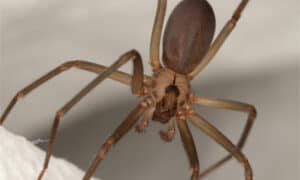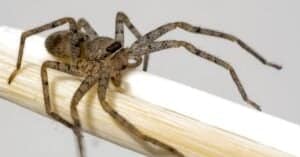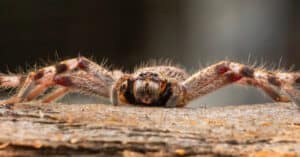Northern Georgia has seen an invasive species bombard their communities. The Joro spider, native to East Asia, is spinning its three-dimensional webs across porches, power lines, gardens, and vegetable patches everywhere you look. Technically, outside of the webbing, the joro spiders in Georgia have yet to cause direct harm to these ecosystems. But they’ve grown to become major nuisances.
Analysts estimate there could be millions of the creatures at this time with the possibility of the population growing and expanding to other parts of the country.
What’s Going on in Georgia?
The proliferation of the Joro spider has blown up social media and even driven people to isolate themselves in their homes. In metro Atlanta, residents are stumped and stunned. They’re inadvertently coming upon the golden webs of a Joro, especially along the Chattahoochee River.
Homeowners are finding the populace thriving in their gardens and trees or making a nice home in their basements and crawlspaces. One homeowner found his front porch suddenly overtaken by Joro webs at least 10 feet deep. That same homeowner says he killed over 300 of the invasive species on his property. The previous year, he’d only dealt with a few dozen.
The number of Joro spiders is already expanding. The creatures are moving into South Carolina and it’s expected the population will continue to spread south. For now, the species seems to be ignoring the natural flows in spider communities. These are often linked to local conditions that effect their prey, such as changes in rainfall.
There is a theory that the Joro spider is thriving in Georgia due to its similar climate to the spider’s original Japanese environments.
Are Joro Spiders a Threat?
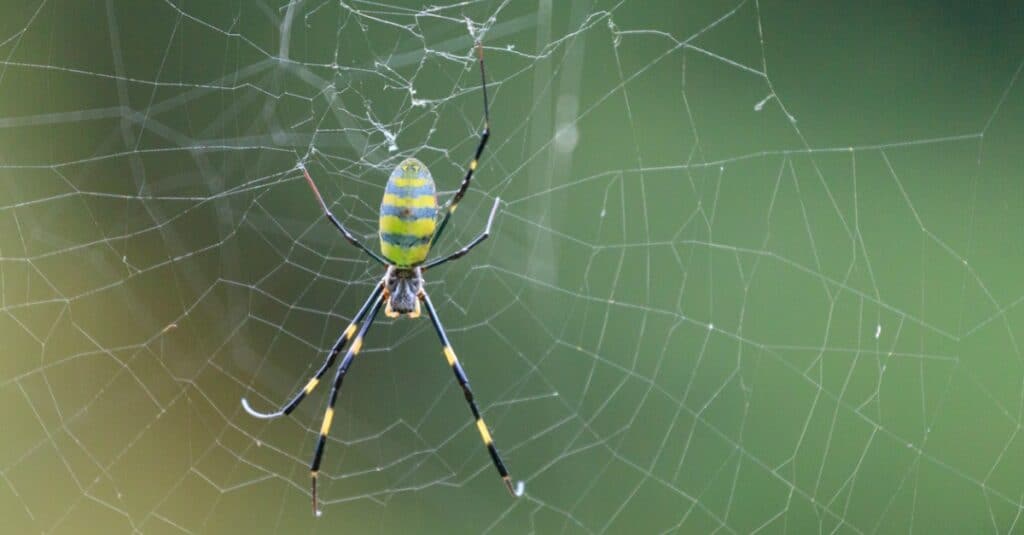
©iStock.com/Jef Wodniack
Outside of the idea of how easily an invasion of creepy crawlies might overwhelm a community, the Joro spider poses no risk to humans or pets. The spiders have the capacity to bite, but their bite is too small to even break the skin. The venom they use to paralyze their prey isn’t strong enough to harm larger animals, though there is the possibility of an allergic reaction.
As the population grows, researchers have yet to agree on what impact these spiders will have on other species and the environment. There are those leaning towards a positive impact. Entomologists point out how Joros feed on unwanted insects, suppressing the population of yellow jackets, biting flies, and mosquitos. The Joro is also a natural predator of the marmorated brown stink bug, a significant threat to Georgia crops and homes.
Still, the scientific community agrees that no assessment of the Joro spider’s impact should be accepted too quickly. They want more research. A team at Clemson University in South Carolina says it’s too early to ascertain if there are negative connotations to this non-native and invasive species on South Carolina’s ecosystems.
Meanwhile, Georgia’s residents have to deal with the size of the growing invasion. Naturalists and garden lovers want to know more about these arachnids, particularly how they’ll affect other native spiders, bees, and other pollinators.
Joro spiders might compete with other orb weavers for food or operate like some spider species, letting native spiders feast on food caught in their webs. There are simply too many unknowns to gauge what may come next. The only thing that scientist are fairly in agreement about is the likelihood the population will continue to increase in the coming years.
Possible problems with an increase in the Joro population is, like most invasive species, that they may out-compete the native spiders. So far, this does not seem to be an issue given that the Joro prefers to prey on insects that other spiders won’t. While the Joro is an invasive species, it is yet to be determined whether it will be harmful or helpful.
How This All Started
The University of Georgia says the first sightings of the invasive species in the state happened somewhere between 2013 and 2014. In 2015, genetic analysis confirmed the sightings while the Georgia Museum of Natural History tracked the spread.
The Joro spider is native to Asia and was only discovered there a decade before they showed up in Georgia. There has been no documented reason for how these spiders — already overwhelming huge portions of East Asia — got to Georgia. The best guess is that it hitched a ride to the United States via a shipping container. They’ve even narrowed that down to a container dropped off in the Braselton area along I-85.
Since its first discovery, the Joro community’s size has grown dramatically and is now found in over two dozen Georgia counties. Shortly after, the crawlers were sighted in South Carolina. The spiders appear to lean toward riparian and urban areas, mostly around houses. They also like to locate deep in wooded areas.
Scientific communities are guesstimating that Mother Nature will eventually balance things out, returning the fast-growing number of Joros to normal levels. For this to happen, some of the native birds, snakes and amphibians will need to acquire a taste for the Joro so that their population will be kept in check by predation.
An Overview of the Joro Spider
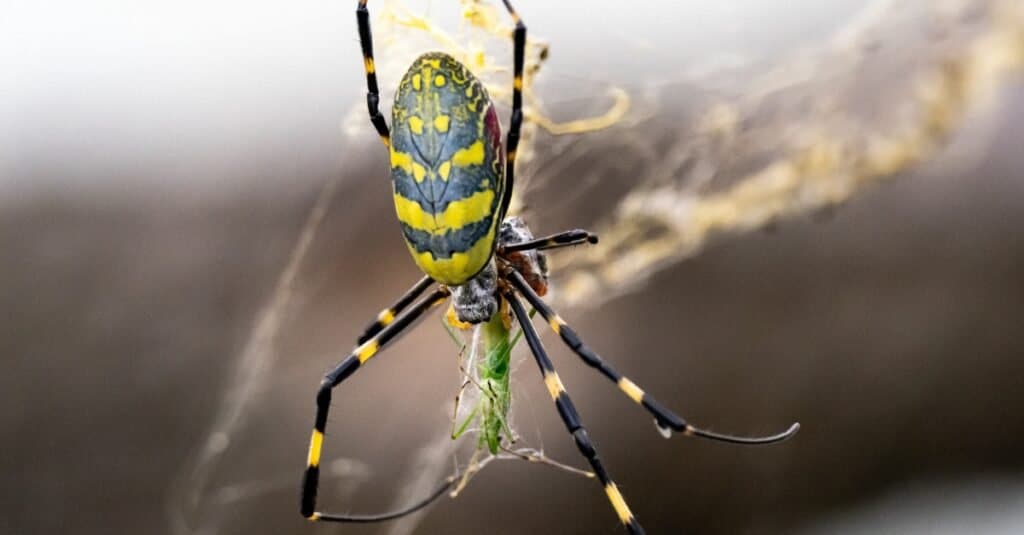
©iStock.com/David Hansche
Not a threat to anything except its natural food, encountering the Joro spider is more a nuisance than anything. Unlike many spiders who spin flat webs, the invasive species create almost three-dimensional webs. Also, they are orb weavers, meaning their wheel-shaped webs are not grayish-white but shiny gold. The webs can be large and multi-layered. Walking into them happens all the time and people are saying they’re sticky and hard to remove.
Females drop sacs of anywhere between 400 and 1,500 eggs. Compare that to the average native species leaving 200 to 500 eggs and you can see how fast the population can grow. Once eggs hatch in the coming spring, the hatchlings hitchhike or ride the wind on a strand of silk, expanding into new habitats.
The Joro male has a brown body. It’s the female who stands out with her bright blue, yellow and red markings that cover their abdomens. What’s truly distracting is that the Joros can measure, with their legs extended, a good three inches across. In contrast, the average house spider is no more than 5/16th of an inch in length.
Prey & Predators
One benefit most of the scientific community attributes to the Joro is the impact the spiders have on pests. They enjoy brown stink bugs, which are a costly pest. The native spider won’t eat them and the stink bug is a significant threat to local agriculture. Joro spiders also feast on mosquitoes and yellow jackets. Another nice thing that’s pointed out is the invasive species do not appear to be displacing native spiders.
As for predators that enjoy the taste of the Joro spider, so far wasps and mud daubers are preying on them.
Up Next…
- Jumpin’ Joros! Do Joro Spiders Jump? Are you worried about being ambushed by giant spiders? It is a scary thought. Check out his article to find out if you really need to worry about it.
- Are Joro Spiders Good? Are They A Helpful Invasive Species? The jury is still out but not all invasive species are bad. Click here to learn more about the possible benefits of having Joros around.
- Joro Spider vs Writing Spider these are both orb-weaver spiders but do they have anything else in common? Find out here.
The photo featured at the top of this post is © iStock.com/David Hansche
Thank you for reading! Have some feedback for us? Contact the AZ Animals editorial team.



